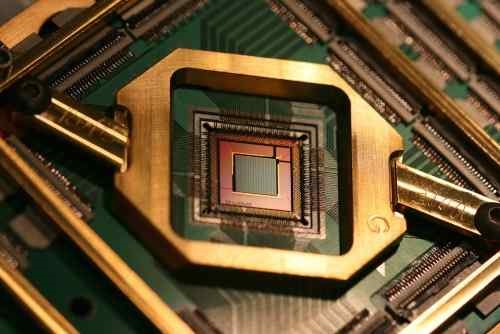By Rich Quinnell, editor, special projects, technical, EE Times
Quantum computing is one of those technologies that is easy to dismiss as too “out there” to worry about today. Even the most optimistic estimates set practical utilization more than a decade off. But the technology involves such a disruptive paradigm shift in computing that prudent developers should begin looking into quantum computing right now.
Discussions of quantum computing tend to focus on its potential to vastly out-perform conventional computing. One application often mentioned in this context is cryptography, specifically the cracking of data security by extracting private encryption keys from protected message traffic. The algorithms for doing so are known, but are so computationally intensive that cracking, say, a 2048-bit RSA encryption key (widely used for securing today's Internet traffic) would take decades even for the fastest supercomputer available. Recent estimates, however, suggest that a quantum computer could crack the code in eight hours .
This alarming prospect — that encrypted communications once thought to be secure long beyond the protected information's useful lifetime may be in danger — is what generated so much excitement about quantum computing in the first place. But code-cracking is not the only application where the technology promises disruptive breakthroughs, and these other opportunities have further fueled interest. Medicine, materials science, molecular biology, and financial applications are all exploring what quantum computing can do for them. And the interest is growing.
In 2018 the US Government passed the National Quantum Initiative Act, creating a National Quantum Coordination Office and providing $1.2 billion to fund quantum information science activities for the next five years. The EU has also authorized funding, up to €1 billion, for a quantum master plan. And China is investing heavily, seeking to leapfrog the US in quantum technology.
Quantum computers are already operational, although currently too simple to outperform traditional computers (a milestone known as quantum supremacy). IBM has made its Q System One computer available for commercial experimentation and research and created a network of partners such as Exxon/Mobile to further the nascent industry. D-wave , Rigetti , and several other companies have also made available functioning quantum computers. Google has a quantum AI research effort, as does Intel, and Microsoft has created its own Quantum Network of software and hardware providers to further the technology.

This processor from D-Wave is one of several operational quantum systems available to application developers exploring the technology. (Image: D-Wave)
So, it's still early days for the technology and many years before it comes out of the research realm into practical application. Yet it is still important for industries to begin exploring the use of this technology today. This early start is necessary because quantum computing is not simply faster computing, it differs dramatically from traditional computing in the way it solves problems. Developers will need the time to become familiar with the new approach so that they are prepared to use quantum computing as soon as it is ready.
Traditional computing achieves its results by following a sequence of steps, called an algorithm, when making its calculations. If seeking to find a value that optimizes or satisfies some complex function, for instance, a traditional computer must algorithmically explore, one after another, all the possible choices. The quantum computer, though, essentially considers all the possible answers simultaneously through the quantum mechanical properties of entanglement and superposition.
To utilize a quantum computer the programmer specifies a series of quantum gates that establish the conditions defining the problem to be solved. This quantum gate setup leverages the probability and wave interference nature of the quantum computer's bits (called qubits or sometimes qbits), to alter an input vector so that the output vector represents a likely answer to the problem. A single run does not produce certainty in its result, however, it merely has a high probability of being correct. By conducting many such trials, the quantum computer can increase that probability to as near certainty as desired. And even though it requires multiple runs to yield an accurate result, the total computational time can be substantially less than the algorithmic approach if the quantum computer has enough qbits in play.
This approach is so different from conventional computing that current computer and programming expertise will essentially be inapplicable to quantum computing. Developers will have to start from scratch to learn quantum computing. The time to start building quantum computing expertise, then, is now.
The Aspencore Network created this Quantum Computing Special Project to help give you that head start. In The Basics of Quantum Computing—A Tutorial we provide insights into how a quantum computer works and where you can develop some experience with them. What’s Next in Quantum Computing? offers a glimpse into the current trends in the technology's evolution. Power supply management in Quantum computers looks at the issues inherent in powering these exotic devices. Finally, we ask Will we need a ‘supercomputer’ on our desk, to explore the business reasons for embracing the technology.
Check out all the stories inside this Quantum Computing Special Project.
The Basics of Quantum Computing—A Tutorial
Advances in quantum computing are happening at breakneck speed. For engineers that want to be a part of its rapid evolution, there are free, hands-on ways to learn the basics and actually experience the technology.
What’s Next in Quantum Computing?
Quantum computing is on a steady upward trajectory, but the field is in flux with new technologies starting to come online.
Power supply management in quantum computers
The road to efficiently powering a quantum computer will require a quantum leap in power management technology.
Will we need a ‘supercomputer’ on our desk?
Cloud computing and big data analysis will require the development of ever more performant computing systems. We can imagine what these high-performance computers might look like as early as 2035.
Advertisement
Learn more about Electronic Products Magazine





